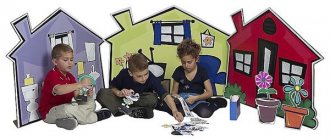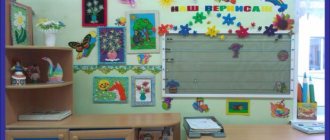Practical recommendations for planning gaming activities (Consultation)
Natalya Simakina
Practical recommendations for planning gaming activities (Consultation)
Planning is an advance determination of the sequence of implementation of a program of educational work, indicating the necessary conditions, means used, forms and methods of work. Planning reflects the implementation of the educational program, taking into account the specifics of the group.
Planning , like any activity, is based on certain principles:
— collegiality ( planning is carried out jointly by group teachers, in interaction with preschool teachers and parents); consistency, regularity of pedagogical influences;
— interaction of different types of children's activities ;
— continuity;
— integrativeness (the child sees the world holistically)
;
- practicality , reality;
— taking into account specific conditions.
Any activity planning serves as the development of actions to achieve a specific goal: educational, developmental, educational. Goal setting is an important stage of planning .
The goals should be:
- clear, specific, understandable;
-real, achievable, comparable to actual capabilities;
- acceptable teachers, parents;
- flexible.
Planning is implemented on the basis of calendar-thematic planning (prospective)
and cyclograms in the form approved by the preschool educational institution.
Principles of calendar and thematic planning :
-Maintaining optimal educational load for children;
-Compliance of the planned pedagogical process with the physiological growth and development of children (biorhythms are taken into account, complex classes are planned on Tuesday , Wednesday):
-Taking into account medical and hygienic requirements for the sequence, duration of the pedagogical process and especially for the conduct of various regime processes;
-Taking into account local and regional climate characteristics;
-Taking into account the time of year and weather conditions. This principle is implemented during walks, hardening and recreational activities, and environmental classes;
-Taking into account individual characteristics (it is necessary to know the child’s temperament type, his hobbies, strengths and weaknesses, complexes in order to find an approach to his involvement in the pedagogical process);
-Reasonable alternation in terms of organized and independent activities (classes, games, club activities, joint work of children and the teacher, as well as free spontaneous play activities and communication with peers);
-Taking into account changes in children’s performance during the week when planning classes and requirements for their compatibility;
-Taking into account the level of development of children (conducting classes, individual work, games in subgroups)
;
-Regularity, consistency and repetition of educational influences (one game is planned several times , but the tasks change and become more complicated - introduce the game , learn the rules of the game, follow the rules, cultivate a friendly attitude towards children, complicate the rules, consolidate knowledge of the rules of the game, etc.);
Conditions conducive to successful planning :
1. Knowledge of software tasks.
2. Knowledge of the individual capabilities and abilities of children.
3. Using the principle of repetition with increasing complexity of tasks (3 - 4 times)
with a small interval.
4. Joint drawing up of a plan by both educators. As well as a constant exchange of opinions on the results of observations of children: how they learn the material covered, how they carry out their duties, what their behavioral skills are, manifestations of what character traits were observed, etc. Thus, the main part of the plan is outlined by both educators, and the details are outlined by each individual.
So how can you optimize your gaming activity ?
First of all, teachers working with children in a preschool institution need to learn how to play with the child.
While playing, we strive to teach children:
· adequately evaluate your actions, rely on your own strengths ;
· anticipate the consequences of role behavior, make choices;
· express your feelings and desires in a way that is understandable to others;
· be self-confident, fair, not only dominate, but agree and submit in the game;
· respect, trust and be able to hear each other.
It is necessary to conduct consultations on problems of gaming activity :
— "Modern approaches to game "
;
— "Development of preschool children in play activities "
;
— “The role of the teacher in the organization and development of gaming activities
senior preschooler."
This also includes the organization of exhibitions, the topics of which are quite diverse:
— “Educational game – a means of development for preschool children”
,
— “Games and toys for theatrical activities of preschool children ”,
— “Subject-based developmental environment for the development of independent story-based games for children.”
When organizing and conducting events, it is necessary to use methods that activate the activities of teachers : master classes, practical exercises the play with your own hands .
to the problem of organizing gaming activities through conversations, consultations , and surveys “What do children play at home?”
, the release of photo newspapers
“We play at home and in the garden”
,
play therapy for child-parent relationships “We play together”
,
game training for dads “Dad can do anything”
, a meeting of
“Mom’s school” “Mom, let’s play!”
.
Complex and thematic planning can include a week-long trip to the magical Igray city.
Such events will add variety to the activities of the preschool institution, enrich the play experience of children , make the stay of preschoolers in kindergarten festive, joyful, emotionally comfortable, and make the participants in the educational process like-minded!
for the gaming task throughout the game , to try to ensure that the mental activity of the players does not decrease during this time, and interest in the task at hand does not fall.
It is necessary to provide children with the opportunity to play at different times of the day: in the morning before breakfast, between breakfast and class, during breaks between classes, during a walk, in the afternoon. Games in the morning help create a cheerful, joyful mood in children for the whole day. Everyone can play their favorite games and team up with friends if they wish. It is not uncommon for children to come to kindergarten with certain play intentions and continue the game they started the day before. If breakfast interrupts the game, it is necessary to give children the opportunity to return to it again after breakfast, during a break between classes. In this case, the nature of the upcoming lesson should be taken into account. Before physical education, quiet games are preferable, and if the activity requires a monotonous position, more active outdoor games or verbal games with a motor component are desirable. It is necessary that the time allocated for games be completely devoted to the game. Sometimes, due to children being overloaded with organized educational activities or due to irrational use of time, play time is reduced. This must not be allowed!
I hope these recommendations will help teachers in their work.
Motor planning and speech
Why did the children in Koltsova’s experiment begin to speak on the third day of work? There is a neurological explanation for this. The children had to perform new actions that required motor planning. But Koltsova could not have known this then - this is a relatively new direction in science.
Motor planning is between the idea and the execution of actions. There are automatic movements that do not require motor planning and are performed in a familiar way. Motor planning appears when a new task appears, when you need to use a new tool, when you need to do something unmastered and unusual in life.
Motor planning is the most complex form of functioning of the nervous system of children. Because planning requires voluntary attention, it is closely related to cognitive functions. Planning requires voluntary attention, which makes the brain able to create messages for the muscles and send them in the required sequence.
The baby picks up the rattle, puts the spoon in his mouth, and crawls over the threshold. You may notice that when performing these movements for the first time, the baby is not in a hurry, he takes each step slowly - he uses motor planning. Once these actions become skills, they no longer require motor planning and are performed easily and quickly, without premeditation.
How does this happen in adults? Motor planning appears when you need to tie an unusual knot, master dance steps or a new operation in production.
Motor planning is a bridge between sensorimotor and intellectual functions of the brain. It depends on sensory integration, which is carried out by the brain stem and other neural structures. The brain "tells" the muscles what to do, and the sensations from the body's receptors (feedback) make the brain able to do it.
Researchers note that most children with various language disorders and autism have motor planning deficits. And this is precisely the root of all troubles in many cases of developmental delay. But how can it be poorly developed if the baby at home has a bunch of educational toys for developing fine motor skills, there are pyramids, lacing, and beads for stringing? What's the answer?
Motor planning appears in the case of new tasks, new unusual situations, new materials, new actions. The key word here is “new”, “unusual”!
When a child already knows his only pyramid by heart, assembles it many times, even quickly assembles it to the delight of all adults, this is not a new action! There is no motor planning here! When he plays with the same lacing, this is also not motor planning, but almost a skill. After all, such a toy is no longer new to him, it is familiar! When he sees the same cards for many days, with which an adult performs the same actions, there is no motor planning here either! Namely, motor planning ensures the developmental effect of exercises.
So what's the conclusion?
1. The very fact of doing exercises for the development of fine motor skills is not important, what matters is what exercises we do with the child and how.
2. The main principle of carrying out exercises and games for the development of fine motor skills is this: if a child can do this movement quickly and easily, then we quickly do it, skip it and move on. But what if the exercise doesn’t work out? Then we stop at it and practice this movement until the movements become easy, simple, fast, beautiful, and clear.
3. It is necessary to do such complexes of exercises and games that are difficult for a child regularly until complete mastery, that is, every day (4-5 minutes).
What does the development of motor planning include in children under 3 years of age?
1. Grasping movements:
- grasping an object of different shapes with the entire palm with one hand or two hands (rattle, cube, ball, etc.), for which it is necessary to take into account its shape, size, location, details
- grasping an object or substance with a pinch (three fingers)
- grasping an object with two fingers - index and thumb (tweezers grip)
2. Development of correlating actions. The ability to combine two objects or two parts of one object (inserts, sorters, pyramids, nesting dolls and other similar toys).
3. Development of finger movements - performing various figures and movements with the fingers (bunny, wolf, house, chair and others). At first, these movements are clumsy, with errors, but over time they become more subtle and clear. It is also important to be able to imitate the movements that an adult shows.
These skills are developed not only in the process of special finger gymnastics, but also:
- while putting on your clothes and fastening them with buttons, buttons, zippers
- during work assignments (from 3 years old - watering, dusting, wiping plant leaves with a sponge, brushing clothes, etc.)
- in visual activities - drawing, modeling, appliqué, design; in games - dressing and undressing dolls in a game, using substitute objects, making toys, attributes for their games, etc. Games and exercises for developing fine motor skills are difficult for babies and therefore should not be lengthy.
- they should be carried out in a game so that the child finds it interesting (sort out the cereal for Cinderella, help the hedgehog hide under his needles from the fox and other game situations).
- if the movement fails, the fingers do not obey, then the game must be repeated many times until the movement is easy, correct, and clear.
You need to slightly change the plot of the game as soon as you notice that the game has been mastered. Don’t be afraid to introduce something new so that the child is passionate about the game and not tired of the monotony: first, make a bridge for the dog out of small pebbles on plasticine. After a while, lay out a path for the doll, then a river for the fish, etc.
All games and exercises must always take place in the presence of an adult to ensure the safety of such games.
Don't use games with buttons. They do not develop fine motor skills (no matter what their manufacturers say), but only distract the child.
List of exercises and games for developing fine motor skills and motor planning in children
For the exercises to be effective, be sure to show your child step by step how to perform them correctly.
1. Rubber bulb (sold at the pharmacy). Choose a small pear. Press it to create a stream of air that can be used to blow cotton wool or a leaf off the table. As an option, you can even play football, trying to force cotton wool into the goal with a stream of air.
2. Playing with raisins is always very joyful for both mother and child and useful for the whole family. Make the dough, roll it out. Invite your child to decorate the dough with raisins. Show how to correctly grasp the raisin (“tweezers grip” with two fingers – thumb and forefinger). Show that the raisins should be placed throughout the dough at a distance from each other. Then bake the resulting pie and eat it with the whole family!
3. Exercises with paper:
- kneading - developing hand strength (after this you will get a “ball” that can be thrown into the basket from a distance).
- tear (development of correlating movements) - grab the sheet with the fingers of both hands and pull in different directions. The result is stripes (these strips can be put in a box and made to “rain” by pouring the strips out of the box). When offering your child paper for this exercise, you should always show him where he can get the paper from. And they themselves must always take paper for this game only from this box. Otherwise, the baby will understand that it is possible to tear everything that is around, and will tear books or something else necessary. For this exercise, have your own place at the table (on the floor, etc.). You can use old rolls of wallpaper for this exercise.
- make appliqués from paper balls (crumple the paper, tear it into strips, then tear the strips into squares, roll each square on your palm into a ball, lay out a silhouette with balls - for example, a cat, a lamb, a cloud).
- make appliqués from pieces of paper that the baby has torn. Draw a picture on a piece of whatman paper. And stick pieces of paper on it according to the plot. White glued pieces can represent snow or clouds, blue ones can represent a river, yellow ones can represent autumn foliage of trees.
4. Sorting small items - it is very important that the child does this either with a pinch (three fingers) or using the “tweezer grip” method, that is, grasped with two fingers - the thumb and forefinger. In this case, the remaining fingers should be tucked in and not interfere. Sorting can take place in the game. For example, our chicken loves peas, and our rooster loves beans. We need to divide the food into bowls for them.
5. Unwrapping an object wrapped in paper - a surprise: “What’s there?” When the child unrolls the paper and finds the gift and plays with it, wrap it again - hide it in another paper. And try to find again. Teach your child to wrap - to hide an object from an older sister or brother, dad, or grandmother. Let them rejoice when his surprise is unwrapped.6. Filling the bottle with small items. You can put beans, pebbles, and balls into a plastic bottle.
For the exercises to be effective, be sure to show your child step by step how to do it correctly:
- grab small objects with either a pinch or two fingers (thumb and forefinger);
- show how you grab an object;
- hold the bottle with one hand;
- with the other hand, take one object at a time;
- at the end of the game, close the bottle with a lid;
- rattle the resulting rattle.
Motor planning skills are not only necessary for fine motor skills. It is known that all speech therapists use articulation gymnastics in their work - a very effective and useful way to develop the muscles of the articulatory apparatus.
When we learn to perform a movement and apply some effort, control is exercised by the premotor cortex of the frontal lobe and the cerebellum (together constituting the lateral system). This work is motor planning, or praxis.
The process of correcting sound pronunciation requires complex motor planning from the child. The child must constantly consciously control the articulatory apparatus until the execution of these movements becomes a skill.
Researchers have shown that children with speech disorders and autism, as a rule, have a pronounced deficit in motor planning. A conflict arises. Speech therapists, speech pathologists, and teachers require complex motor planning specifically from children for whom it causes great difficulties. How does this happen in sports? A tennis coach first teaches a child to run, hold a racket, and hit the ball. Only then, after a very long time, does the child learn to play tennis. It's the same with speech.
The preparatory stage, the foundation for mastering articulatory (speech) exercises, is physical education. It is physical education that stimulates the development of the child’s lateral system, gradually developing motor planning. In this case, it is not the set of movements that is important, but the rhythm in performing the movements and feedback. It is this system that makes the process of developing movements, including articulatory ones, most effective.
By performing simple movements with your child: steps, running, jumping, bending, squats, etc. to music, a tambourine or counting, you help the child master the complex skill of motor planning of general movements. Sometimes difficulties in motor planning look like awkwardness, lack of coordination of movements. These may seem unrelated to speech, but they are part of the same process.
Parents think that clumsiness, balance and coordination problems are more likely to be characteristics of the child, rather than neurological problems, but these “features” are signs of disorders of the brain stem and cerebellum. They are often diagnosed in children with delayed speech and mental development, autism spectrum disorders, Asperger syndrome, behavioral and attention disorders.



